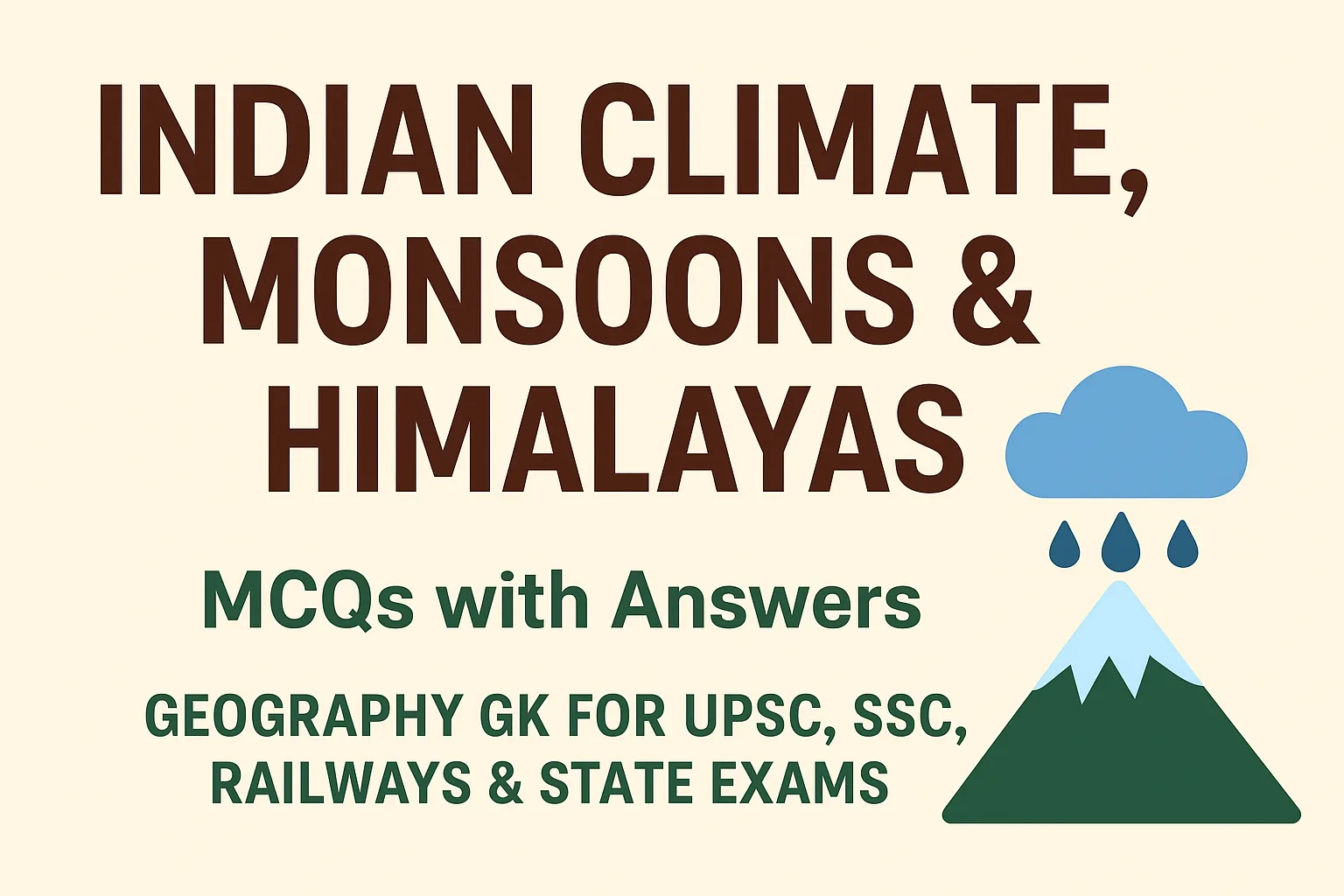India’s land and weather have a big effect on its way of life, farming, and economy. The rainy monsoon winds and the high Himalayan mountains are both very important. The Himalayas protect the north, and the monsoon brings needed rain every year. For exams like UPSC, SSC, Railways, and State PSCs, many questions are asked about India’s weather, seasons, mountains, and world geography. These MCQs are made for you to cover a large number of topics and important mountain ranges around the world.
The climate of India is generally described as which of the following types, mainly characterized by the seasonal reversal of winds bringing rainfall to the Indian subcontinent?
a) Mediterranean type of climate
b) Monsoon type of climate
c) Desert type of climate
d) Temperate oceanic type of climate
Answer: b) Monsoon type of climate
How does the rainfall pattern change from east to west in the Northern Plains of India?
a) Increases from west to east
b) Increases from south to north
c) Decreases from east to west
d) Remains uniform throughout
Answer: c) Decreases from east to west
. Which of the following is a direct impact of El Niño on India?
a) Heavy floods in North India
b) Failure or weakening of monsoon rainfall
c) Excess snowfall in the Himalayas
d) Strong cyclones on the west coast
Answer: b) Failure or weakening of monsoon rainfall
Due to the moderating influence of the seas, which regions of India experiences the least seasonal contrast in temperature ?
a) Rajasthan
b) Northern Plains
c) Peninsular coastal areas
d) Himalayan region
Answer: c) Peninsular coastal areas
Thiruvananthapuram has an average maximum temperature of 31°C in January and 29.5°C in June mainly due to:
a) High latitude location
b) Moderating influence of the sea
c) Desert climate
d) Mountain barrier effect
Answer: b) Moderating influence of the sea
Rajasthan has a very high annual range of temperature mainly because it is:
a) Surrounded by seas
b) Located in the Himalayan foothills
c) An interior region with continental climate
d) Covered with dense forests
Answer: c) An interior region with a continental climate
In which region of India is the difference between day and night temperatures the highest, often ranging from 50°C during the day to 15°C at night?
a) Thar Desert
b) Northern Plains
c) Western Ghats
d) Assam Valley
Answer: a) Thar Desert
Which of the following regions of India hardly shows any noticeable difference between day and night temperatures?
a) Rajasthan
b) Andaman and Nicobar Islands
c) Punjab
d) Ladakh
Answer: b) Andaman and Nicobar Islands
In Northern India, the cold season is generally characterized by:
a) Hot days and warm nights
b) Warm days and cold nights
c) Uniform hot climate
d) Very heavy rainfall
Answer: b) Warm days and cold nights
The reason why coastal areas in India generally experience moderate climate is because:
a) The altitude of the coast is high
b) The sea absorbs heat slowly and releases it slowly
c) These areas are covered with evergreen forests
d) They are closer to deserts
Answer: b) The sea absorbs heat slowly and releases it slowly
In India, the cold weather season generally lasts from:
a) November to February
b) December to February
c) January to March
d) October to December
Answer: b) December to February
The Himalayas came into existence due to the collision between:
a) Indo-Australian Plate and Eurasian Plate
b) Pacific Plate and Eurasian Plate
c) African Plate and Indian Plate
d) Antarctic Plate and Arabian Plate
Answer: a) Indo-Australian Plate and Eurasian Plate
What kind of mountains are the Himalayas?
a) Residual mountains
b) Block mountains
c) Fold mountains
d) Volcanic mountains
Answer: c) Fold mountains
The Himalayas are divided into how many parallel ranges from north to south?
a) Two
b) Three
c) Four
d) Five
Answer: b) Three
The highest peak located entirely in India is:
a) Nanga Parbat
b) Kanchenjunga
c) Nanda Devi
d) Kamet
Answer: b) Kanchenjunga
Tamil Nadu receives most of its rainfall during:
a) Winter season
b) Retreating monsoon
c) Southwest monsoon
d) Pre-monsoon showers
Answer: b) Retreating monsoon
Mango showers, important for the ripening of mangoes in southern India, occur due to:
a) Winter rainfall
b) Retreating monsoon
c) Local convectional rainfall in April–May
d) Cyclones in the Bay of Bengal
Answer: c) Local convectional rainfall in April–May
Which Himalayan pass connects India with Tibet and is famous for trade?
a) Nathu La
b) Shipki La
c) Jelep La
d) All of the above
Answer: d) All of the above
Which region receives rainfall twice from monsoons, once from the southwest and again from the northeast?
a) Rajasthan
b) Punjab
c) Tamil Nadu
d) Maharashtra
Answer: c) Tamil Nadu
The transition season between summer and winter, characterized by cyclonic rainfall in coastal areas, is called:
a) Pre-monsoon season
b) Post-monsoon or retreating monsoon
c) Cold weather season
d) Hot weather season
Answer: b) Post-monsoon or retreating monsoon
The highest peak in India (presently in POK region under Pakistan) is:
a) Kanchenjunga
b) Mount Everest
c) Nanda Devi
d) K2 (Godwin Austen)
Answer: d) K2 (Godwin Austen)
According to Koeppen, which climate type is designated as ‘Am’ (Monsoon with short dry season)?
a) Tropical Rainforest Climate
b) Tropical Monsoon Climate
c) Tropical Savannah Climate
d) Humid Subtropical Climate
Answer: b) Tropical Monsoon Climate
In Koeppen’s classification, the letter ‘B’ is used for which type of climate?
a) Dry Climates
b) Cold Climates
c) Tropical Climates
d) Polar Climates
Answer: a) Dry Climates
Which Köppen climate type is most suitable for describing the climate of Rajasthan desert?
a) Aw
b) Cw
c) Bs
d) Bw
Answer: d) Bw
The Kashmir Himalayas are drained by which major river system?
a) Ganga
b) Indus
c) Brahmaputra
d) Sutlej
Answer: b) Indus
40. Which among the following is

